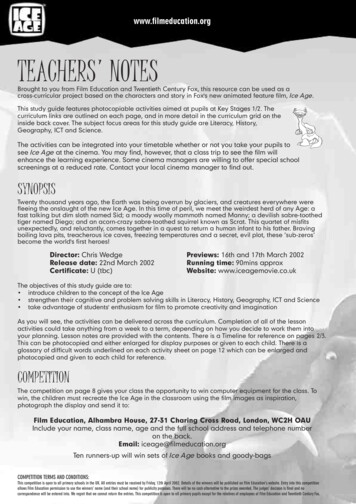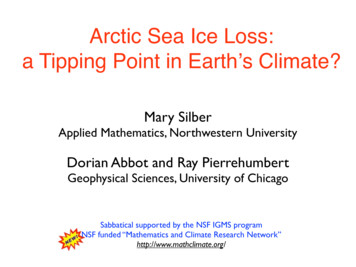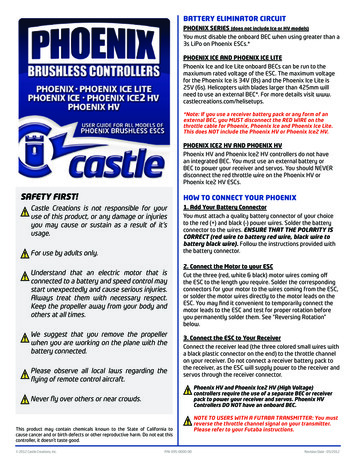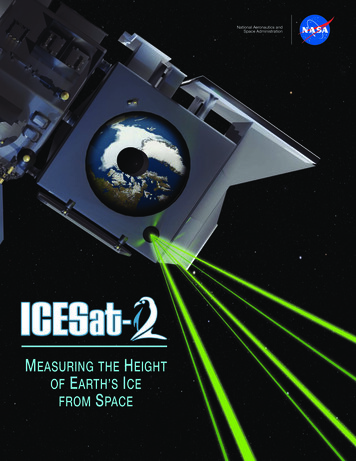
Transcription
oceanwww.oceanexplorer.noaa.govFloridaExploring the Submerged New World 2009The Puzzle of the Ice Age Americans(Adapted from the 2002 Submarine Ring of Fire Expedition)FocusOrigin of the first humans in the AmericasGrade Level9-12 (Biology/Anthropology)Focus QuestionWhen did the first humans arrive in North America, where did theycome from, and how did they get here?Learning Objectivesn Students will be able to describe alternative theories for how the firsthumans came to the Americas and explain the evidence that supportsor contradicts these theories.n Students will be able to explain how exploration of a submergedportion of the northeastern Gulf of Mexico coast may provideadditional insights about the origin of the first Americans.n Students will be able to describe the role of skepticism in scientificinquiry.Materialsq Copies of History of Ice Age Americans Inquiry Guide, one copy for eachstudent or student groupAudio-Visual Materialsq NoneTeaching TimeOne or two 45-minute class periodsSeating ArrangementClassroom style or groups of two to four studentsMaximum Number of Students32Image captions/credits on Page 2.Key WordsMonte VerdeBeringia1
www.oceanexplorer.noaa.govExploring the Submerged New World 2009: The Puzzle of the Ice Age AmericansGrades 9-12 (Biology/Anthropology)Daisy CaveIce-free corridorMeadowcroft Rock ShelterKennewick ManClovis FirstClovis pointsSinkholeBackground InformationNOTE: Explanations and procedures in this lesson are written at a levelappropriate to professional educators. In presenting and discussing thismaterial with students, educators may need to adapt the language andinstructional approach to styles that are best suited to specific student groups.The origin of the first people to inhabit North and South America hasbeen a subject of controversy for decades. In 1927, archaeologistsworking near Folsom, New Mexico discovered a stone spear pointembedded in the rib cage of an extinct bison. This discovery provideddirect proof that humans and large extinct mammals co-existed fora time, and that humans had arrived in North America by the end ofthe Pleistocene epoch (about 11,000 years ago). Several years later,distinctive long spear points were discovered at an archeological sitenear Clovis, New Mexico, along with bones of prey dated to as far backas 11,200 years ago.Images from Page 1 top to bottom:The eastern Gulf of Mexico showing the threesub-areas examined in 2008, the Florida MiddleGrounds, and the Suwanee River paleo /09newworld/background/plan/media/fmg surveyareas.htmlDuring the Late Pleistocene Florida’s shorelineextended much farther offshore than the present coast. The Florida Middle Grounds were partof the exposed coastal ene.htmlMap of the Bering land bridge during the lateWisconsin glaciation, when global sea leveldropped to about 120 meters or more below itspresent s/09newworld/background/occupation/media/beringia late wisconsin.htmlThis image portrays a more accurate reconstruction of Ice Age human behavior with a focuson small familial groups and the processingand use of plants as opposed to athletically fityoung men attacking large, dangerous ehavior.htmlAll images courtesy NOAA.During the years following discovery of sites at Folsom and Clovis, atheory developed that became widely accepted as fact, even thoughthere was very little supporting evidence. This theory proposed thatthe first humans to enter North America were a small group of huntersthat migrated from Asia by walking across a land bridge betweenAsia and North America about 13,500 years ago, passing through aninland ice-free corridor in western Canada. These pioneers, called“Clovis people,” carried thrusting spears tipped with specialized stonepoints that made them very successful hunters of the large mammalsthat inhabited North America. Their success allowed the first groupto rapidly expand throughout North and South America, and afterapproximately 1,000 years the Clovis people are supposed to haveexterminated 33 genera in North America and more than 50 generain South America. The key element of this theory is that the “Clovispeople” were the first human inhabitants of North and South America;hence this theory has come to be known as the Clovis First model.There were several problems with the Clovis First model. One problem isthat the distinctive stone spear points that are a key part of the modelhave not been found in Siberia which is supposed to have been thepoint of departure for the pioneers. A related problem is that the stonepoints found in the United States appear to be older than points foundin the far north. In addition, other stone projectile points, shaped2
Exploring the Submerged New World 2009: The Puzzle of the Ice Age AmericansGrades 9-12 fferently than the Clovis points,have been found at sites in theUnited States that are just as oldas the Clovis specimens. Possiblythe most serious problem was thediscovery of sites in North andSouth America that are much olderthan the Clovis sites.The geological clock: a projection of Earth’s 4.5Ga history on a clock (“MA” a million years(Megayear) ago; “GA” a billion years (Gigayear)ago). Image credit: Woudloper, ic clock.jpgNote: “Snowball Earth” refers to periods ofwidespread glaciation; details of the SnowballEarth theory continue to be controversial andare being investigated under the auspices of theInternational Geoscience Programme.There are also difficultiesconcerning the proposed timingof the “Clovis migration.” Whenhumans arrived in the Siberianarctic about 32,000 years ago,there were ice-free corridorsalong the Pacific coast and inlandeast of the Canadian Rockieswhich provided a conduit to theAmericas. By about 24,000 yearsago these corridors were closedby ice. The coastal corridors wereprobably open again by 15,000years ago, but the interior corridordid not re-open until 14,000 13,500 years ago. A Paleoamerican settlement in southern Chile namedMonte Verde was in existence 14,600 years ago, so it is unlikely thatthe humans who settled there had migrated via the inland corridor; butthey could have arrived via the coastal route.Artifacts dating from14,100 BP, found,Paisley Cave, ORTime Line of Earliest Americans(Dates are approximate)32,000 BPHumans had learnedto subsist in Siberia’sextreme environment30,000 BP32,000 BPIce free corridors (coastaland interior) existedproviding a conduit tothe AmericasArtifacts dating from22,000 - 18,000 BPfound, Meadowcroft, PA25,000 BP24,000 BPCorridors were closedby ice20,000 BPArtifacts dating from14,400 BP found, Artifacts dating fromPaige-Ladson, FL 13,100 - 13,000 BPfound, Arlington Springs,Santa Rosa Is, CAArtifacts dating fromArtifacts dating from14,600 BP found,11,500 - 10,500 BPMonte Verde, Chilefound, Clovis, NM15,000 BP10,000 BP5,000 BPPresent15,000 BPCoastal corridorsopen again14,000 - 13,500 BPInterior corridorsopen again3
www.oceanexplorer.noaa.govExploring the Submerged New World 2009: The Puzzle of the Ice Age AmericansGrades 9-12 (Biology/Anthropology)Recently, molecular genetics has provided new insights into the originsof the first Americans, and archaeologists have studied new sites andre-visited others with new methods. Genetic evidence now suggeststhat members of a single population of modern humans (Homo sapiens)entered North America from Siberia sometime between 30,000 and13,000 years ago. Most studies suggest that the migration occurredless than 22,000 years ago, and probably involved boats. Once theyreached the Pacific Northwest they could have continued dispersingsouth along the coast to eventually reach Chile, as well as dispersingeastward along the margins of the continental ice sheets. Some ofthe oldest archaeological sites discovered in North America are in theeastern United States. The Meadowcroft, Page-Ladson, and PaisleyCave sites, for example, have ages estimated at 18,000 - 22,000,14,400, and14,100 years ago, respectively (Goebel et al. 2008) (seeLearning Procedure, Step 4). Other sites may be even older, but arestill being evaluated. There are also numerous quarry-campsites in thesoutheastern states. Quarries are locations where raw rock materialwas mined and processed to make tools. If a reliable source of wateris nearby, residential sites are often found near the quarry. Theseobservations may indicate that these sites were occupied longer thansites in other regions.Side scan sonar image showing near shore sandridges associated with the Last Glacial Maximum. The blue line in the center of the figureshows the track of the side-scan sonar. Imagecredit: newworld/background/plan/media/lgm ripples.htmlCoastal areas were almost certainly inhabited by early Americans, butare difficult to explore because the coastlines of 15,000 years ago arenow under more than 300 feet of water! As the last ice age drew to aclose, melting ice sheets caused a rapid rise in sea level just as thefirst Americans were entering the New World. Drowned settlementsmay contain well-preserved artifacts that can provide important newinformation about how the first Americans lived and when they arrivedat various locations in North and South America. The eastern Gulf ofMexico in the vicinity of the Ocala Uplift Zone is particularly promisingas a potential location for drowned coastal settlements because: There are numerous onshore archaeological sites along the samezone that are more than 13,000 years old; Clusters of similar sites have been identified along drownedshorelines in the northern Gulf of Mexico; Rivers that discharge into this part of the Gulf do not carry largequantities of sediment, so sites should not be deeply buried; The coastal shelf is gently sloped which would reduce the impact ofwaves and storms; and Rapid sea level rise would have reduced the impact of waves ascoastal settlements were inundated.When the first Americans arrived in Florida, sea level was much lowerand there was more than twice as much dry land as exists today. Theclimate was considerably drier, and water was scarce. Not surprisingly,early American settlements that have been discovered in the state arealmost always associated with a reliable water supply such as rivers4
www.oceanexplorer.noaa.govExploring the Submerged New World 2009: The Puzzle of the Ice Age AmericansGrades 9-12 (Biology/Anthropology)and springs. These areas would also have been attractive to animals,increasing the likelihood that human hunters would be able to findfood. Florida is sometimes nicknamed the “sinkhole state” becausethe limestone that underlies much of the state is gradually dissolvedby acidic water (normal rainwater is slightly acidic) that createsunderground caves, which sometimes collapse to form sinkholes.Sinkholes provide natural reservoirs for fresh water, and some ofthe most artifact-rich paleoamerican sites are located near theseformations. This association means that archaeologists looking forearly American settlements along drowned shorelines of Florida canlook for sinkholes as indicators of promising sites.The Northeastern Gulf of Mexico 2008 Expedition focused onancient river channels in the vicinity of the Florida Middle Grounds,which are now several hundred feet below the Gulf’s surface. Majoraccomplishments included: Locating and high resolution mapping of a large, essentially intact,and infilled ancient river channel several kilometers long, east ofthe Florida Middle Grounds; Identifying additional stream and river channels, some with clearlyvisible deposits along the banks; Locating and identifying more than 100 sinkhole features filled withmaterial in stratified layers that may contain human artifacts aswell as plant and animal material from early American times; and Mapping nearly 10 square kilometers of intact, shallow-water,nearshore sand ripples/ridges adjacent to an area that would havebeen Florida’s shoreline when sea level was at its lowest pointduring the last glacial period.The latter achievement is particularly important because it shows thatthe oldest shoreline is extraordinarily well preserved. Most interesting,though, are the infilled sinkholes with multiple layers of distinct strata.These sinkholes are a potential treasure trove of new information aboutthe late Pleistocene landscape and environment, and the humans wholived there.This lesson guides a student inquiry into theories about the origins ofhumans in the Americas, and provides an opportunity for reflection anddiscussion about the process of scientific inquiry.Learning Procedure1. To prepare for this lesson: Review introductory essays for the Exploring the SubmergedNew World 2009 Expedition at rld/welcome.html; and Review questions on the History of Ice Age Americans Inquiry Guide.5
www.oceanexplorer.noaa.govExploring the Submerged New World 2009: The Puzzle of the Ice Age AmericansGrades 9-12 (Biology/Anthropology)2. Briefly review the background and mission of the Exploring theSubmerged New World 2009 Expedition. Explain the background tothe Clovis First theory and the theory’s major features. List someof the problems with the theory. Lead a discussion of how scientifictheories evolve and change. In general, skepticism of change is animportant part of science, and new theories have to be supported bysubstantial evidence. On the other hand, it is also important for newevidence to receive a fair hearing. The history of science containsmany examples of visionaries whose ideas were considered ridiculousfor many years before they were finally accepted as correct.3. Distribute the History of Ice Age Americans Inquiry Guide. Divide thequestions evenly among students or student groups. Have studentsprepare oral or written reports on the questions they are assignedto research. Emphasize that there may be more than one answer forsome questions.4. Have students present results of their inquiries in a seminarformat. Encourage discussion of various pieces of evidence, aswell as speculation on possible explanations that have not beeninvestigated. When all results have been presented, have eachstudent write a brief summary describing what they believe to be themost probable explanations of when, how, and from where the firstAmericans arrived in North America. The following points should beincluded in the discussion:(1) Monte Verde, an archaeological site in Chile, is widelyacknowledged to have been inhabited between 12,500 and14,600 years ago, and has a large number of artifacts that areexceptionally well-preserved. This evidence conflicts with theClovis First theory.(2) Beringia is a region that includes present-day Alaska, the YukonTerritory, northeast Siberia, and the now-submerged Bering Seaplatform. It is believed that during the last Ice Age, the BeringSea platform formed a land bridge that connected Asia and NorthAmerica.(3) The Meadowcroft Rock Shelter site in Pennsylvania containsartifacts that may be 18,000 - 22,000 years old. The Page-Ladsonsite in Florida contains tools and a mastodon tusk that areestimated to be about 14,400 years old. At Paisley Cave, in Oregon,three human coprolites (fossilized fecal material) were found withan estimated age of about 14,100 years. All of these observationsare inconsistent with the Clovis First theory.(4) The Ice Free Corridor hypothesis is part of the Clovis First theory.This hypothesis suggests that the first humans to enter NorthAmerica arrived from Siberia after crossing a land bridge, then6
www.oceanexplorer.noaa.govExploring the Submerged New World 2009: The Puzzle of the Ice Age AmericansGrades 9-12 (Biology/Anthropology)migrated through an inland passage between the Laurentide andCordilleran ice masses. These ice masses blocked all inland routesfrom 24,000 years ago until 14,000 - 13,500 years ago.(5) Dr. Carol Mandryk is a paleoecologist at Harvard University whohas investigated prehistoric vegetation in Alberta, which wouldhave been at the southern end of the “ice-free corridor.” She hasfound that there was not enough biomass to support humansuntil after 13,000 years ago, and that the corridor was not openuntil 11,500 years ago. In addition, her research shows that evenafter the ice sheets began to open a path, there was not enoughvegetation there to support the large animals that migratingpeople would have had to depend on for food.(6) While inland routes were blocked by ice until at least 14,000 yearsago, coastal routes were open to migration at least 15,000 yearsago. So, the first Americans could have arrived by boat.(7) Arlington Springs is on Santa Rosa Island in the northernChannel Islands off the southern coast of California. Humanremains have been found at Arlington Springs that are estimatedto be 13,000 - 13,100 year old. Santa Rosa Island was an islandeven during the Ice Ages, so it could only have been reached byboat. These observations support the idea that some of the firstAmericans may have traveled by sea, which is an alternative to theland migration proposed in the Clovis First theory.(8) Australia has been isolated by water since at least 60 millionyears ago. There is evidence that humans have been present inAustralia for at least 40,000 years, and no explanation has beenproposed for how they could have arrived other than by boat.This suggests that boats may also have been available to the firsthumans to enter the Americas; again, suggesting water travel asan alternative to the land migration proposed in the Clovis Firsttheory.(9) DNA studies suggest that the first Americans came from a singlepopulation in Siberia, and migrated from Beringia sometime after16,500 years ago.(10) Students should realize that the scientific method is based ontesting hypotheses. To help resolve debates about theories suchas Clovis First, scientists need to make predictions based on thetheory, and then test whether these predictions are true. In thecase of Clovis First, one prediction might be, “There is no evidenceof human occupation in North America before 11,500 years ago.”If no evidence was found after investigating many sites, this wouldsupport the theory. But the theory would not be proven, because7
www.oceanexplorer.noaa.govExploring the Submerged New World 2009: The Puzzle of the Ice Age AmericansGrades 9-12 (Biology/Anthropology)a single site older than 11,500 would demonstrate that the theoryis incorrect. But if supporters of the theory deliberately blockfunding for research on sites that might be older, then the theorycannot be disproven—even though such sites might exist. Withthis kind of constraint, key predictions cannot be tested, so thescientific method cannot be applied.The BRIDGE Connectionwww.vims.edu/bridge/archeology.html – For links to lesson plans andresources about marine archeologyThe “Me” ConnectionHave students write an essay on why the question of the origin of thefirst Americans is or is not worthy of publicly supported research.Connections to Other SubjectsEnglish/Language Arts, Geography, Earth ScienceEvaluationStudents’ research reports and class discussions provide opportunitiesfor assessment.Extensions1. 1. Visit rld/welcome.html for more about the Submerged New World 2009Expedition.2. Visit http://www.pbs.org/wgbh/nova/first/ for information andresources about the discovery and controversy surrounding a wellpreserved, 9,000-year-old human skeleton called Kennewick Man.Multimedia Discovery /welcome.htmlClick on the links to Lessons 7 and 10 for interactive multimediapresentations and Learning Activities on the Water Cycle and Tides.Other Relevant Lesson Plans fromNOAA’s Ocean Exploration Program(The following Lesson Plans are targeted toward grades 9-12)The Robot Archaeologist(17 pages, 518k) (from AUVfest auvfest/background/edu/media/robot.pdfFocus: Marine Archaeology/Marine Navigation (Earth Science/Mathematics)8
www.oceanexplorer.noaa.govExploring the Submerged New World 2009: The Puzzle of the Ice Age AmericansGrades 9-12 (Biology/Anthropology)In this activity, students will design an archaeological survey strategyfor an autonomous underwater vehicle (AUV); calculate expectedposition of the AUV based on speed and direction of travel; andcalculate course correction required to compensate for the set and driftof currents.My Wet Robot(300kb) (from the Bonaire 2008: Exploring Coral Reef Sustainabilitywith New Technologies us: Underwater Robotic Vehicles (Physical Science)In this activity, students will be able to discuss the advantages anddisadvantages of using underwater robots in scientific explorations,identify key design requirements for a robotic vehicle that is capable ofcarrying out specific exploration tasks, describe practical approachesto meet identified design requirements, and (optionally) construct arobotic vehicle capable of carrying out an assigned task.Do You Have a Sinking Feeling?(9 pages, 764k) (from the 2003 Steamship Portland g.pdfFocus: Marine Archaeology (Earth Science/Mathematics)In this activity, students plot the position of a vessel given twobearings on appropriate landmarks, draw inferences about a shipwreckgiven information on the location and characteristics of artifacts fromthe wreck, and explain how the debris field associated with a shipwreckgives clues about the circumstances of the sinking ship.Other ResourcesThe Web links below are provided for informational purposes only.Links outside of Ocean Explorer have been checked at the time of thispage’s publication, but the linking sites may become outdated or nonoperational over time.http://oceanexplorer.noaa.gov – NOAA’s Ocean Explorer Web k/welcome.html#book – A free printable book for home and school useintroduced in 2004 to celebrate the 200th anniversary ofNOAA; nearly 200 pages of lessons focusing on the exploration,understanding, and protection of Earth as a whole system9
www.oceanexplorer.noaa.govExploring the Submerged New World 2009: The Puzzle of the Ice Age AmericansGrades 9-12 (Biology/Anthropology)http://www.kumeyaay.com – Web site dedicated to the promotion andpreservation of the Kumeyaay culture, with extensive informationpresented from the Kumeyaay hp – Web site for the Centerfor the Study of the First cans.html – Online articleon issues and evidence relating to peopling of the New Worldhttp://www.pbs.org/wgbh/nova/first/ – Web site to accompany theNOVA presentation, “Mystery of the First Americans” (originallybroadcast on February 15, 2000) documenting the discovery andcontroversy surrounding a well-preserved, 9,000-year-old humanskeleton called Kennewick Man; includes “Does Race Exist?,” “MeetKennewick Man,” “Claims for the Remains,” “The Dating Game” (aboutcarbon-14 analysis), and links to htm – National ParkService Archaeology and Ethnography Program’s Web site, TheEarliest AmericansGoebel, T., M. R. Waters, and D. H. O’Rourke. 2008. The Late PleistoceneDispersal of Modern Humans in the Americas. Science t/abstract/sci;319/5869/1497Full article available from Science Magazine for 15.Bowdler, S. 1997. The Pleistocene Pacific. In D. Denoon (ed). TheCambridge History of the Pacific Islanders. pp. 41-50. CambridgeUniversity Press, Cambridge. Article by Bowlder is available on lineat boulder/the pleistocene pacific.National Science Education StandardsContent Standard A: Science As Inquiry Abilities necessary to do scientific inquiry Understandings about scientific inquiryContent Standard G: History and Nature of Science Science as human endeavor Nature of scientific knowledge Historical perspectives10
www.oceanexplorer.noaa.govExploring the Submerged New World 2009: The Puzzle of the Ice Age AmericansGrades 9-12 (Biology/Anthropology)Ocean Literacy Essential Principles andFundamental ConceptsEssential Principle 2.The ocean and life in the ocean shape the features of the Earth.Fundamental Concept b. Sea level changes over time have expanded andcontracted continental shelves, created and destroyed inland seas, andshaped the surface of land.Fundamental Concept e. Tectonic activity, sea level changes, and forceof waves influence the physical structure and landforms of the coast.Essential Principle 6.The ocean and humans are inextricably interconnected.Fundamental Concept a. The ocean affects every human life. It suppliesfreshwater (most rain comes from the ocean) and nearly all Earth’soxygen. It moderates the Earth’s climate, influences our weather, andaffects human health.Fundamental Concept b. From the ocean we get foods, medicines, andmineral and energy resources. In addition, it provides jobs, supportsour nation’s economy, serves as a highway for transportation of goodsand people, and plays a role in national security.Fundamental Concept c. The ocean is a source of inspiration, recreation,rejuvenation and discovery. It is also an important element in theheritage of many cultures.Fundamental Concept d. Much of the world’s population lives in coastalareas.Essential Principle 7.The ocean is largely unexplored.Fundamental Concept a. The ocean is the last and largest unexploredplace on Earth—less than 5% of it has been explored. This is the greatfrontier for the next generation’s explorers and researchers, where theywill find great opportunities for inquiry and investigation.Fundamental Concept d. New technologies, sensors and tools areexpanding our ability to explore the ocean. Ocean scientists are relyingmore and more on satellites, drifters, buoys, subsea observatories andunmanned submersibles.11
www.oceanexplorer.noaa.govExploring the Submerged New World 2009: The Puzzle of the Ice Age AmericansGrades 9-12 (Biology/Anthropology)Send Us Your FeedbackWe value your feedback on this lesson.Please send your comments to:oceanexeducation@noaa.govFor More InformationPaula Keener-Chavis, Director, Education ProgramsNOAA Ocean Exploration and Research ProgramHollings Marine Laboratory331 Fort Johnson Road, Charleston SC 29412843.762.8818843.762.8737 his lesson plan was produced by Mel Goodwin, PhD, The HarmonyProject, Charleson, SC for NOAA’s Office of Ocean Exploration andResearch. If reproducing this lesson, please cite NOAA as the source,and provide the following URL: http://oceanexplorer.noaa.gov12
Exploring the Submerged New World 2009: The Puzzle of the Ice Age AmericansGrades 9-12 e Puzzle of the Ice Age AmericansHistory of Ice Age Americans Inquiry Guide1. The Clovis First theory proposes that the first human inhabitants of North andSouth America crossed a land bridge from Siberia at some time before 13,000years ago. These people were sophisticated hunters, and spread rapidly acrossNorth America. This theory was proposed after stone spear points were discoverednear Clovis, NM with an estimated age of 11,200 years.Does evidence from an archaeological site named Monte Verde support or conflictwith the Clovis First theory? Explain why.2. What is Beringia?3. How do discoveries at Meadowcroft Rock Shelter, Paisley Cave, and the PageLadson site relate to the Clovis First theory?4. What is the “ice-free corridor hypothesis,” and how is it related to the Clovis Firsttheory?13
www.oceanexplorer.noaa.govExploring the Submerged New World 2009: The Puzzle of the Ice Age AmericansGrades 9-12 (Biology/Anthropology)The Puzzle of the Ice Age AmericansHistory of Ice Age Americans Inquiry Guide – 25. Who is Carol Mandryk and what does her research show?6. If inland migration routes were blocked by ice until at least 14,000 yearsago, how could people have entered North America to inhabit sites such asMeadowcroft, Paisley Cave, and Page-Ladson?7. What is the significance of Arlington Springs to the Clovis First theory andalternative migration routes?8. How does the arrival of humans in Australia relate to findings at ArlingtonSprings?9. What do DNA studies reveal about when early Americans may have left Asia?14
www.oceanexplorer.noaa.govExploring the Submerged New World 2009: The Puzzle of the Ice Age AmericansGrades 9-12 (Biology/Anthropology)The Puzzle of the Ice Age AmericansHistory of Ice Age Americans Inquiry Guide – 210. The Clovis First theory was vigorously debated for decades. Commenting on thecontroversy, Bonnichsen and Turnmire (1999) state:“In scientific research, debate should be regarded as a normal part ofthe process of advancing knowledge. Unfortunately, the debate over thepeopling of the Americas has not operated in this manner. Rather than usingthe debate as a positive forum for testing competing hypotheses about theinitial peopling of the Americas a very conservative group of Late-Entryadvocates has systematically attacked all claims for pre-12,000-year-oldoccupation in the Americas Perhaps the worst consequence of the debateis that it has become next to impossible to raise research funds throughcompetitive grantsmanship to conduct research at archaeological localitiesthat may be great
there were ice-free corridors along the Pacific coast and inland east of the Canadian Rockies which provided a conduit to the Americas. By about 24,000 years ago these corridors were closed by ice. The coastal corridors were probably open again by 15,000 years ago, but the interior corridor did not re-open until 14,000 - 13,500 years ago.











